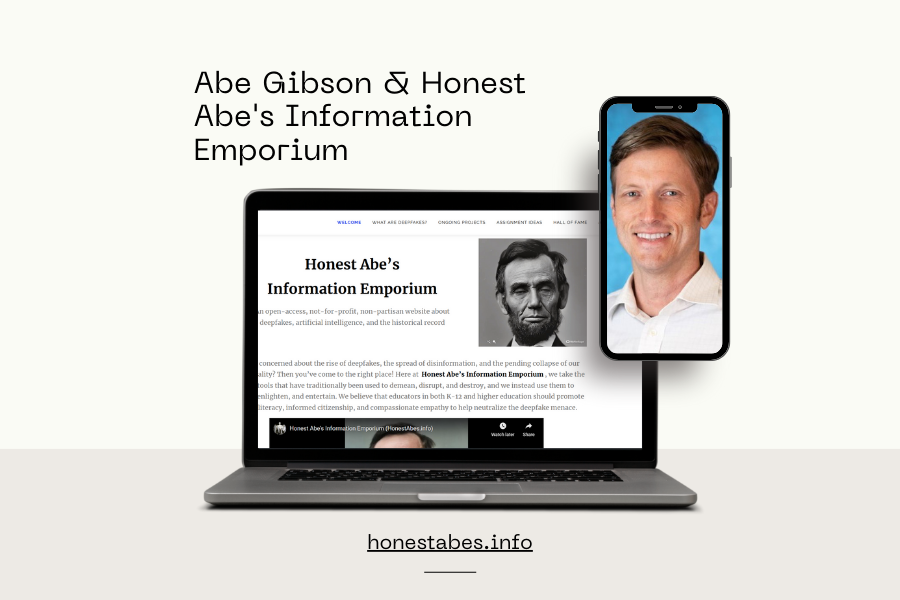Abe Gibson (FSU History PhD 2013) & Honest Abe's Information Emporium: An Interview

Tell us a bit about yourself.
I'm originally from Virginia, but I moved to Tallahassee for grad school in 2008. I studied the history of science and environmental history with Fritz Davis, and I earned my PhD in History from FSU in fall 2013. My dissertation was entitled: “Born to be Feral: The Evolutionary History of Domestic Animals in the American South.” Go 'Noles!
What is your current job, what do you do?
I am currently an assistant professor in the Department of History at the University of Texas at San Antonio. I teach courses on the history of science, technology, data, and the environment. My research interests are in Digital History and the history of science.
You recently started the project “Honest Abe.” What is it about?
This project examines the impact that artificial intelligence could have on the historical record and the historical profession. I was especially curious about the sudden rise of deepfakes, generative AI, and other synthetic media. And so, I recruited several students and several colleagues in the UTSA History Department, and we created the website Honest Abe's Information Emporium, where we use AI-powered tools to experiment with the historical record in a variety of silly, serious, and uncanny ways. We named the site Honest Abe’s because we use Abe Lincoln as a standard variable for our all experiments… and because I’m a narcissist who wanted to see my name on the marquee. I wasn’t actually named after Abe Lincoln, but I’m more than happy to cash in on his good name.
So, for example, using a smartphone app that “animates” historical photographs, we created a deepfake video of Abraham Lincoln reciting the Gettysburg Address in nine different languages. For another experiment, we used a variety of AI-powered tools to create 500 fake photographs of Lincoln that one could easily mistake as real. For yet another experiment, we used GPT4 to rewrite the Gettysburg Address in the style of different writers. Those are just a few examples. We wanted to ask how these tools could affect the historical record, and to have some fun in the process.
What is the major aim of the project?
We have a couple of aims. First, we want to alert our fellow historians, our fellow teachers, and our fellow Americans to the latest developments in AI. There is a LOT of hype surrounding AI right now, and so it's important to have a clear understanding about what tools exist, what they can do, and what they can't do. For example, it’s now possible to mimic any voice using AI, which means you can make anyone say anything. That’s helpful to know as we try to navigate this Brave New World of synthetic media. At the same time, we should bear in mind that these tools are not magic, and they’re not infallible. If we’re going to engage with AI, then we need to know its blind spots. More generally, I think everyone involved is hoping the site will promote digital literacy, informed citizenship, and greater empathy for all people.
How did you come up with the project? How does it tie into your overall goals as an educator?
I first started thinking about these sorts of questions back in 2018, when Jordan Peele released a video that appeared to show President Obama saying things that were wildly out of character. By the end of the video, you learn that Peele is controlling the avatar, and the whole thing is a Public Service Announcement about deepfakes and misinformation. It dawned on me that deepfakes also could have profound implications for the historical record, and that, in turn, could raise serious questions about the historical profession. Namely, how can we safeguard the authenticity of the historical record when AI can automate the generation of fake artifacts and fake texts at scale? How do we proceed when fake media outnumbers the genuine variety?
In terms of my goals as an educator, the best thing we can give our students is hope. AI poses some seriously daunting and dehumanizing challenges. Rather than just surrender to nihilism or relativism, we can show students how to meet the challenge, how to take back control, and how to use AI tools for good rather than evil.
What were the major challenges you encountered in designing the project, the website, the different AI-powered manipulations?
I have zero formal training with computers, and so I'm learning a lot of stuff on the fly. More importantly, I'm relying almost entirely on tools and smartphone apps that anyone can access for free. I'm not trying to make convincing deepfakes for thousands of dollars. I'm more interested in finding out what one can create on the cheap.
How did your students participate in the project?
Several students contributed to the "Gettysburg Address in Global Translation" project, which is probably the coolest thing on the entire site. As I mentioned before, we had ten different people recite the Gettysburg Address in 9 different languages. I am also working with several other students to develop lesson plans that will help K-12 teachers utilize AI in the classroom.
How can other educators use it in the classroom?
That remains to be seen. Most of the tools that I used for this project didn't even exist a mere 12 months ago. Who knows what things will look like in another year? I would just advise educators to always be proactive. Always ask yourself how a given tool can be used in the classroom, and how it can be used to help students learn.
Final thoughts?
In addition to myself, there are two other FSU alumni working on this project: Daniel Hutchinson (History PhD, 2011) and Cindy Ermus (History PhD, 2014).

